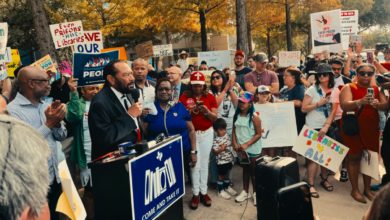In January 2007, Washington, D.C. Mayor Adrian M. Fenty won an overwhelming electoral victory in large part due to his repeated promises to reform education. But recently, his administration has proposed the closure of 23 schools and the firing of nearly 500 school employees. This is indeed a “reform,” but a reform in the wrong direction, which neglects the needs of students, parents and working-class people in the district.
In April 2007, the Washington, D.C. City Council voted to strip the school board of its direct control of the city schools,
 |
On Dec. 18, 2007—in the first major move since Fenty’s takeover—the city council voted 10-3 to give Michelle Rhee, chancellor of schools, the power to fire without cause all the school system’s non-union employees. The jobs of 100 to 150 employees are on the chopping block, and 488 workers are at risk. At a press conference, Rhee called the City Council vote a “momentous day” and “amazing first step.”
If the council approves the final legislation on Jan. 8, 2008, as expected, the rights of all city workers, especially those who are not unionized, would be immediately at risk. Some employees are likely to lose their jobs as early as February.
The city council is also expected to approve a bill giving Rhee the funds to close 23 public schools. The closings will include 14 elementary schools, six middle and high schools and three special education centers. The closings are scheduled to take effect in the 2008-09 academic year. Fenty has said he will decide in late January 2008 which schools to close after getting a final recommendation from Rhee.
The council also unanimously approved legislation providing $81 million to fill a gap in the schools’ budgets. But an unspecified portion of that money will be used to finance the closings. Why is it that the city can find money to close schools, but claims it is in financial straits when it comes to covering workers’ salaries?
The firings set a disturbing precedent for all city workers. As Nathan A. Saunders, general vice president of the Washington Teachers’ Union pointed out in an interview, “Whenever someone comes in to take over a department or city agency, you know the first thing they are going to ask for? The same rights given to the chancellor [to fire city employees].”
Unions representing school employees initiated a radio campaign critical of the proposed firings. The city government establishment quickly struck back with a radio campaign of their own conducted under the guise of a nonprofit organization D.C. Children First, whose board members include former mayor Anthony A. Williams and two former D.C. City Council members.
Hundreds of parents have protested the proposed school closings. On Dec.11, 2008, more than 50 parents from Bruce-Monroe Elementary School marched to a meeting with Chancellor Rhee, holding signs opposing the school closings.
Responding to Rhee’s claims that she will consider public feedback before making final decisions, parent Joy Parker said: “Why are you asking these questions? It sounds like you’re going to do this anyway.”
Dissenters in the city council have also voiced their opposition. Council member and former mayor Marion Barry plans to introduce legislation mandating that the city council approve any closings.
Council member Harry Thomas complained that council members should have been consulted before the proposed closings were made public.
Barry’s district, Ward 8, and Thomas’s district, Ward 5, will lose four schools and seven schools, respectively. Schools in the wealthier areas of the city, like Ward 3, will not be subject to closure.
If all the proposed changes are enacted in D.C., it is likely to influence outcomes in other cities as well. “The eyes of the nation are on D.C.,” Rhee said.






